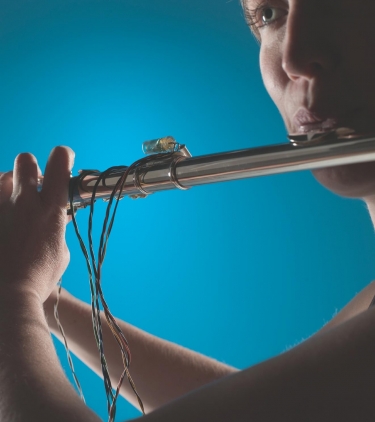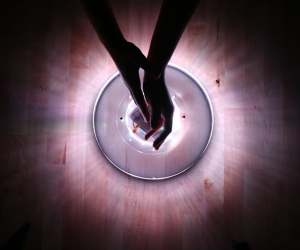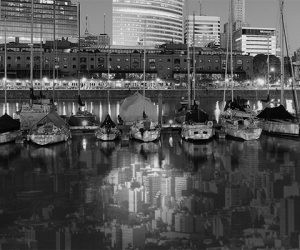
“My work as a composer is eminently solitary. I feel like an island, but each island is a world, and in turn I am composed of these many worlds.” This is how Montreal composer, hyper-flute inventor, and performer Cléo Palacio-Quintin describes her work. Introspective and speaking in metaphor, she appears more apt to read aloud from a book of contemporary poetry than to design a Max patch. Palacio-Quintin offers land surrounded by water as her musical self-portrait. But these aren’t picture-postcard islands. Imagine the main island as composed of gleaming wired monoliths vibrating with sound and reaching to the future. One should approach the chain of islands with a sense of adventure, prepared for diverse and expansive experiences, for each island has its particularities, forces, and expression; all are connected, yet each is distinct.
The Cléo isles comprise a composer, teacher, award nominee, adviser, and most importantly, an instrument inventor. Palacio-Quintin’s pieces range through the electronic, the acoustic, and the improvisatory. She is in the running for the Conseil Québécois de la Musique’s prestigious Opus award for composer of the year and will finish her doctorate work at the University of Montreal in 2011. Then there is her constant organizational involvement in the contemporary music milieu: teaching, international conferences and workshops, and artistic committee work with Montreal’s SMCQ. Palacio-Quintin is fully engaged with creative new music. Most notable among her achievements is the invention of the hyper-flute—an instrument interfaced to a computer by means of electronic sensors. Integral to her work is her quest for a balance between her intimate artistic sensibility and the ever-evolving technological innovations offered to an astute contemporary creator: on the one hand, her breath, the flute, and poetic text in its most primordial essence; on the other, the vast, intriguing terrain of treating sound with electronics and digital processing. Facets to be reconciled in the Cléo archipelago.
The main island: hyper-flute
It was in the ’90s, during her flute studies at the University of Montreal, that she first glimpsed the possibilities offered by augmenting her flute. “I am, above all, an instrumentalist. I wanted to find other possibilities for my instrument, and that opened the door to the world of electronics and the development of my hyper-flute,” reflects Palacio-Quintin.
In 1998 she was working on a real-time sound-treatment piece with Louis Dufort and David Cronkite, and she remembers the moment that electronics came into focus. “It was the first time I heard my sound transformed by computer. It was like a bolt of lightning. However, I wanted to be the one to control the computer. I was certain that if I could, the sound details would be more interesting.”
Shortly afterward, while studying at The Hague in the Netherlands, with the technical assistance of engineers, she developed the hyper-flute. Efforts at augmenting the sound of different instruments existed previously, but Palacio-Quintin’s innovation involved using captors in the flute to control the Max patches. Experimentation with the flute’s sound driving Max patches was unprecedented. American flutist and pioneer of extended techniques on the flute, Robert Dick was also an important source of influence. As a student, her work with the contemporary experimenter opened the way to developing a pallet of new sounds.
Recent explorations by Palacio-Quintin seem to indicate an obsession with sound-control technologies. In the hyper-flute, she uses interfaces sensitive to gesture, such as the commercially applied Wimode—the innovation used in the game platform Wii, that allows everyone to play video games through virtual interaction. Given the history of music, twelve years is a short time for such an evolution as occurred in Palacio-Quintin’s work with the hyper-flute. But we are in electronic real time (not to be confused with chronological time), and technical possibility appears to expand unendingly, as if a boundless territory.
Palacio-Quintin views the use of technology as making her work more accessible, broadening her public rather than narrowing it. “The use of technology is part of my musical language; it’s part of the time and world I live in. My tools are the computer, the Web, tape, etc.,” she says. But she doesn’t use technology for technology’s sake. “My use of technology depends on the artistic needs of each piece.” Playing the flute with sensors allows the audience to see the movements that influence the sound. “More and more, I think, there needs to be a gesture which helps create a context for listening to music. Spectators appreciate the connection.” This way, in addition to providing a massive inventory of sound possibilities, technology is a visual facilitator in a concert situation.
Tides of breath
La marée dans la bouche (“the tide in the mouth”) is a commissioned, six-minute, three-part work created by Palacio-Quintin in 2009 for a literary event that paired writers with composers. Scored for bass flute, bass clarinet, and electronics, it integrates Québec writer Kim Doré’s poem of the same title in an intriguing, recent example of Cléo’s affinity for poetic text and real-time sound treatment. “I wanted above all to illuminate Doré’s magnificent text. It evokes powerful, troubling images for me, both beautiful and sometimes nostalgic.”
It is Doré’s recorded voice reciting the poem that is heard in variations in the piece. The piece was created using the Max/MSP technology and programmed by the composer. Sound produced by the instruments and the electroacoustic component of the piece is treated live, extending tone textures, reverb, and distortion, in dialogue with the sensual and intimate poem. Intriguingly, in the second section the software randomly selects fragments of the text.
If one could shred whispers with the wind then blow those bits through an immense sonorous tube, the result might resemble the opening of La marée dans la bouche. It leaves a figurative impression requiring no abstract jump to imagine airy tides of breath and words advancing and receding in the mouth. It is a stormy night on a Cléo island, and a voice whispers, I dreamed of fragments . . . I learn to whisper . . . One hears time ticking as instrument-keys are clicked in the harmonic gusts, then silenced. Time is stopped, a voice informs us. For the listener, there is abandonment and fascinating desolation in this place where wind tides echo and blow: decrepit buildings and enormous rusty objects, their parts pulled loose, catch the edges of the tone-rich air. The sound is continuous, layered, dense in overtones, and becomes rhythmic with the full text recitation and the presence of a second voice in the closing section of the piece. These gale forces will not outdo the words, and the poet’s voice insists on having its say, if not also overcoming them. But La marée is perhaps a dream, as is suggested in the opening words, and the bass rumbling that closes the piece carries the voice away in its tidal flow.
The allure of newer, more, faster
The allure of newer, more, faster is as omnipresent in the field of electronic music as elsewhere. In a recent piece, Palacio-Quintin was able to use live spectral sound transformation. The effect was made possible through the rapid calculation of information by a new, powerful computer. Still, in the speed game there are some surprising limitations. It raises the question of the longevity of musical works. After continuous upgrading, computer and software used to perform older pieces becomes obsolete. She says, “The relation to my instrument is still at the heart of my musical practice. The physical production of the sound is intimate and essential for a flutist. Although the sound I can produce with the hyper-flute is augmented by electronics, I still have to drive the initial sound. I remain intimately connected with it, and that makes a big difference. Everything you hear comes initially from my acoustic instrument.”
Recently, a demanding concert schedule required that she return to a daily multi-hour practice schedule to reconnect with the challenge and pleasure involved in playing her acoustic instrument: “You never finish learning your instrument. This fact becomes even more expansive with the hyper-flute because the electronic extensions keep distancing the horizons. The story of my life is searching for the balance between how to work within limits while continuing to expand possibilities.”
No easy choices
Technology does things fast but it still takes time. You have to learn the gear, test it, apply it, and drive it. Playing an instrument expressively is famously demanding: countless hours of scales, arpeggios, exercises, and studies. The dilemma of how to spend your hours is the riddle of these fast times. Perhaps it’s always been so. Cléo Palacio-Quintin cuts the issue of choices this way: “Sometimes I use old technology because I know it well, and even if it is antiquated, the result will be more interesting, artistically, than if I’m using something with which I am still unfamiliar. But when I know there is a zone of exploration that interests me and I really want to go there, I find the technology.”
Choice. Perhaps humans still have an edge over machines. Maybe not. So far, a day is still made of twenty-four hours. Age and the physical body impose their limits, as everyone learns eventually. The question remains an important one for the creative artist: given the prowess and speed of technological innovation, is there time to reflect on whether we like the results of the sounds produced by the new gear? I hope so.
Creating is essential for Cléo Palacio-Quintin. Plugged in or unplugged, her artistic output is remarkable and still expanding. In recent projects, she has begun integrating video into her work. When she was young she wanted to be an architect. Instead she builds new sound islands in the Cléo archipelago.
Audio: La marée dans la bouche (2009). Composed by Cléo Palacio-Quintin. Text from La marée dans la bouche by Kim Doré. Performed by Lori Freedman (bass clarinet), Cléo Palacio-Quintin (bass flute and live electronics), and Kim Doré (pre-recorded voice). Image: Cléo Palacio-Quintin playing the hyper-flute. Image by: Carl Valiquet.


